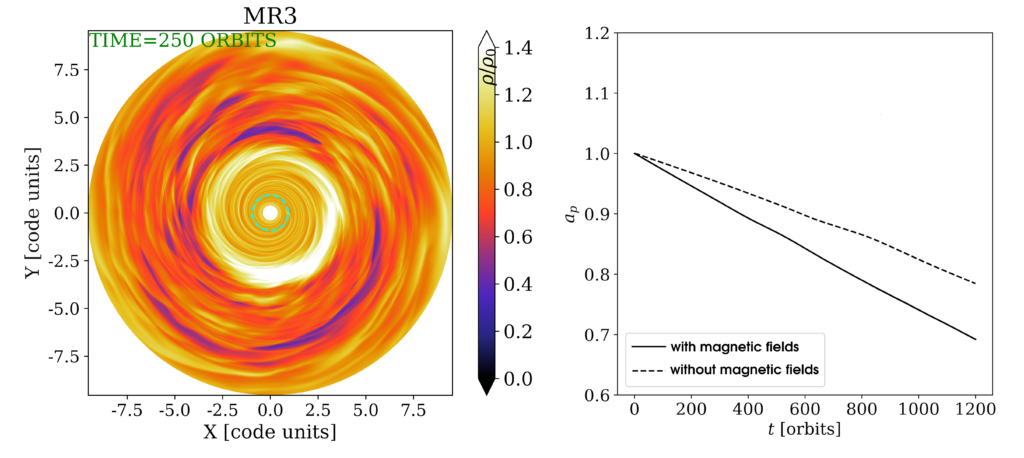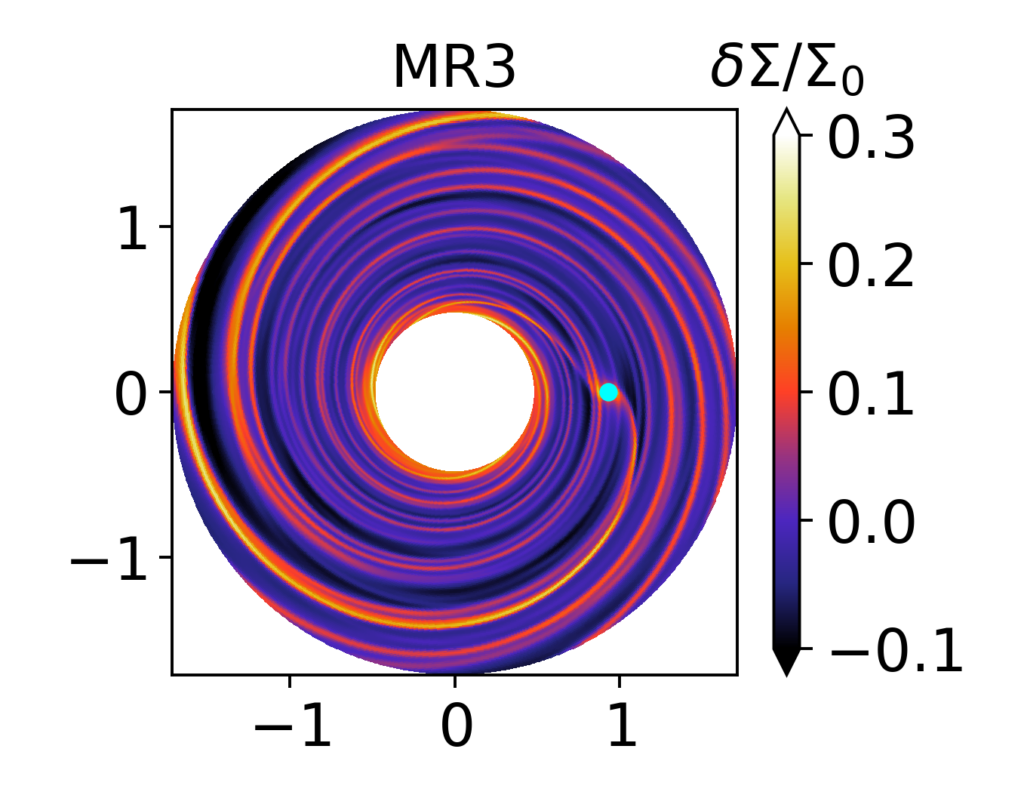Title: On wave interference in planet migration: dead zone torques modified by active zone forcing
Authors: R. O. Chametla, O. Chrenko, W. Lyra, N. J. Turner
First Author’s Institution: Charles University, Faculty of Mathematics and Physics, Astronomical Institute, Prague, Czech Republic
Status: Published in ApJ [open access]
Magnetic fields are extremely common in the universe. It comes as no surprise that they can play a big role in the formation and evolution of planets. The authors of today’s paper investigate the influence of magnetic fields on the location of a planet embedded in a protoplanetary disk.
How can a planet change location in a disk?
Planets form in protoplanetary disks, and although the lifetime of a disk is much shorter than the lifetime of a planet, there is a phase when the planet has already formed and the disk still exists. Planets in this phase are called embedded planets.Embedded planets interact with the disk, which can lead to the planet changing its orbital distance. This process is called planetary migration. In order to migrate, a planet needs to change its orbital velocity and therefore exchanges angular momentum with the disk, because it is a conserved quantity. This means that in the overall system, the amount of angular momentum stays constant.

One of the main mechanisms for angular momentum exchange is the excitation of spiral arms by the planet (see Figure 1). They occur because the planet pushes the disk material to the sides, creating density waves. Because the orbital velocity of the material in a disk depends on the distance to the star, the density waves get smeared out into a spiral shape. Once the spiral arms have formed, they can pull and push the planet around: the outer spiral arm removes angular momentum from the planet, causing it to decelerate and migrate inwards. Vice versa, the inner spiral arm adds to the planet’s angular momentum and pushes it outwards. Simulations show that the outer spiral arm tends to “win” the fight, which means the planet migrates inwards in most cases.
Can magnetic fields influence planetary migration?
Magnetic fields are little trouble makers: they tend to make physics highly complex, which is why they are often neglected. But in order to get the complete picture of planet formation and evolution, they need to be investigated as well. The authors of today’s paper take the step to include magnetic fields into their simulation.
Charged particles, also called ions, are affected by magnetic fields. They are coupled to the field and can only flow along the magnetic field lines. Ions are, however, not evenly distributed within a disk. In fact, there is a region at the mid-plane of the disk where it is cold, but dense. Here, the disk material is mostly neutral, because due to the low temperature, only few particles become ionized, and when they do, they easily find a partner to recombine. This region is called the magnetic dead zone. Magnetic fields are still present, but neutral particles are not affected by them.

Some investigations so far have shown that magnetic fields can greatly influence the migration of planets. In some cases, the force on the planet causing it to migrate can fluctuate so rapidly that the migration is reminiscent of a random walk. However, because magnetic fields are so complicated to describe in theoretical models, different models can show different results. The authors of today’s paper perform three-dimensional simulations including magnetic fields to investigate how the spiral structure in a disk changes with magnetic fields present. Such simulations take a lot of computation time due to their complex physics. The authors find that planets migrate inwards faster when magnetic fields are present (see Figure 2, right panel).

The authors trace the faster migration rate back to the formation of a vortex, an accumulation of disk material, at the outer edge of the magnetic dead zone. The vortex also excites spiral arms, which the authors call background spirals. They show a different shape than the spiral arms launched by the planet, because there is a different physical mechanism causing them. The authors find that the differently shaped spiral arms interfere with each other.
In Figure 3, the authors find that the spiral arms in the inner region between the planet and the star are suppressed because of destructive interference and that the outer spiral arms are enhanced by constructive interference. This makes the outer spiral arm even stronger, which is why the planet migrates inwards faster when magnetic fields are present.
This is the case for low mass planets (below a hundred Earth masses). Higher mass planets open a gap in the density structure of the disk and for those planets, the authors find a similar migration rate in the scenarios with and without magnetic fields, only that the planet halts further away from the star. The authors investigate the shape of the gap and find that planets in disks with magnetic fields can create a deeper gap, as shown in Figure 4.

They further find that the gap is more asymmetric with magnetic fields and argue that this could lead to different migration rates for higher mass planets. However, this is a study left for future work.
Although there is still a lot of work to be done to completely understand the behavior of planets in disks with magnetic fields, the authors of today’s paper took a big step forward towards understanding the role of magnetic fields in protoplanetary disks.
Reference note: Title in the style of the beginning of the song “Freak magnet” by the Violent Femmes.
Astrobite edited by Jessie Thwaites
Featured image credit: Lina Kimmig




